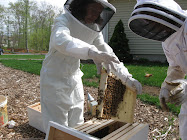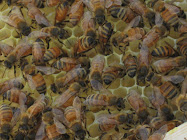Monday, April 12, 2010
Welcome Spring!
Monday, September 14, 2009
Hens, Bees, Peaches and Apples









Monday, July 6, 2009
Life is . . .
Sunday, April 5, 2009
Our Progress towards Sustainability


Wednesday, March 18, 2009
I cannot wait . . .











Sunday, March 8, 2009
One thing off the to do list




Saturday, March 7, 2009
Well, I've done it!

Friday, February 27, 2009
Canning and Preserving

Thursday, February 19, 2009
My First Bee Class

- The teachers were very enthusiastic about the positive effects keeping bees has on your garden / orchard. They said that the bees make an enormous difference. As I mentioned last fall, on a large sprawling pumpkin plant with numerous blossoms, I only got three pumpkins. I actually tried my hand at hand-pollinating my summer squash plants because the blossoms kept falling off -- fruitless. This worked, but it was labor intensive!
- Many fruits and vegetables need to be pollinated up to 5 times to produce good "fruit".
- The honey bee is a very docile bee.
- The teachers were quick to point out that yellow jackets give the honey bee a bad name.
Friday, October 10, 2008
A day in the life of me . . .
 Here are my tomato plants. They are now hanging upside down in my garage. If the weather is getting too cold you can save your tomatoes by doing this and believe it or not they ripen slowly on the upside down vine. Cool eh?
Here are my tomato plants. They are now hanging upside down in my garage. If the weather is getting too cold you can save your tomatoes by doing this and believe it or not they ripen slowly on the upside down vine. Cool eh?Look at this beautiful rose! I had to include it. Isn't it gorgeous?
My peppers are working hard to ripen before hard core cold weather moves in.
Here is my cold frame work. Paint is drying. Right now I'm trying to get the nerve up to use the circular saw. Power tools give me the willies. I always feel like I'm going to lop off a limb. Scary. Notice my cute little fruit trees in the background and the pile of wood chips I have yet to finish putting around them (sigh).
Here is our front door dressed for fall. Of course the hay I'll be using in my garden as mulch -- Hello Garlic!
Friday, September 26, 2008
Ways that we have saved
- Got rid of the "lawn guy" left over from when I was a single working mother.
- Got rid of the cleaning lady left over from when I was a single working mother.
- Got rid of cable.
- Got rid of long distance phone service. (we use our cell phones for long distance)
- We brew our morning coffee. It is a rare treat to buy coffee at a store of any kind. Think of all of those wasted cups we save! This is a huge savings. Just think: 2 cups a day at $2 each x 365 = $730 and let's face it, a lot of people buy more than one cup a day -- and $2 won't cover fancy coffee from places like Starbucks.
- Victor pretty much always brings a lunch to work. Usually it is leftovers from the night before that I pack into a glass container when we do the dishes after dinner. $6 x 5 days a week = $30 x 52 weeks a year = $1560. See how it adds up?
- Started air drying our clothes -- winter, summer, spring and fall (indoors and outdoors)
- Turned our thermostats down to 66 degrees (during the months it's cold here) during the day and 55 degrees at night.
- Put in a large garden in our back yard -- I'm in the midst of making cold frames to grow things in the cold months as well.
- We are in the midst of chopping wood (we have tons of it in our large yard -- one large one got struck by lightening and we had to cut two down to give my garden more light) to help heat our house this winter -- we have oil heat and I'm petrified!
- Put in a small orchard
- Started composting -- free "fertilizer"!
- Started driving our own trash / recyclables to the dump. With recycling and composting we generate one medium bag of trash every 2 weeks. One bag is $1.50 to bring to the dump. $1.50 x 26 weeks a year = $39 a year. When we had trash service it cost $35 a month x 12 months = $420 a year. Total savings: $381 a year.
- Committed to using things that aren't disposable that you have to keep buying -- like paper towels (use dish clothes and towels) paper napkins (cloth napkins) swiffers & kitchen wipes (rags and elbow grease) ... you get the idea.
- Cook from scratch. This is a HUGE savings, AND you will be eating better tasting food that is better for you.
- Make things instead of buying things. The sky is the limit here. Make your own laundry and dishwasher soap. Knit mittens from left over yarn. Everything you do will have a big impact. The more you do, the better.
- Use the library. Most have a network so that you can "order" books from cooperating libraries. There are few things you cannot find.
- Buy used things from thrift stores. Less expensive and better for the environment. Great combo!
- Eat less meat. Did you know that cows and pigs - their waste - causes more damage to the environment than our cars? It's the methane gas released into the air from the er .... poo. Supposedly if each family ate just one less MEAT MEAL we could dramatically effect our environment for the better. Anyway, that's the added bonus of eating less meat. Not only do you get to help the environment, you also get to save big time at the grocery store. Plus, let's face it, it's healthier to eat less meat. For the past month or two we've been eating a MEAT MEAL about once a week. Plus, if you have your own garden like I do, just eating all of the ripe veggies is enough to keep you busy and well fed!
- Started to make our own laundry soap, dishwasher soap, glass cleaner and furniture polish. Link info here.
- Make our own bread.
- Bought a woodstove -- goodbye $600 oil bill!
How about you? Are you working on ways to save?
Sunday, September 14, 2008
Fall Harvest


Thursday, June 12, 2008
Make a note of it ...
Monday, May 19, 2008
Baltimore Orioles

I don't know if the Baltimore Orioles are reading my blog, but they have come to mate in my yard. They are gorgeous. Their "call" is beautiful, powerful and loud. I've been gawking at them as they chirp back and forth marveling at how pretty they are. However, I just read that they eat fruit (also bugs, nuts, seeds and nectar). Thank God for fruit tree nets. No fruit for you guys from my little orchard. Speaking of my little orchard. I have one sweet cherry tree, one Chinese apricot tree, one Bartlett pear tree, one Anjou pear tree, two peach trees, one Fuji Apple tree, one three-in-one grafted apple tree, one Cortland apple tree (for pies especially) and six tall blue berry bushes. Fun! Of course it will be a few years for anything substantial, but hopefully by then I will have really ironed out the organic spraying thing. Keep well! Happy gardening.













































